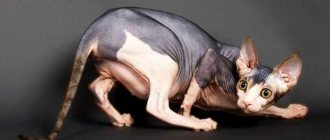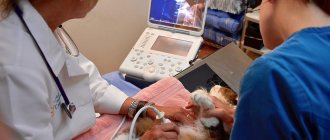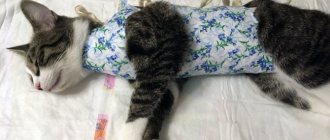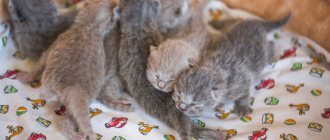The pregnancy of a Bengal cat goes through the same process as in other breeds of pets. Its duration is on average 65 days. If there are a lot of kittens, this period may be shortened, and when the pet is carrying no more than two babies, on the contrary, it may increase. In order for kittens to be born healthy, Bengal owners need to correctly find a male for mating, and also become familiar with the harbingers of upcoming labor.
General information about pregnancy in Bengals
After the mating season, which for this breed lasts from five to eight or nine days (cats successfully become pregnant, according to statistics, in 90 percent of the total number of matings), the time comes to bear offspring. Special blogs offer descriptions of how a cat’s appearance changes from week to week in pictures.
Is your cat pregnant or is she imagining it?
After lovemaking, fertilization may occur, but it may turn out to be a false pregnancy. One of the reasons for the phenomenon is sterile sexual intercourse. At the same time, a false pregnancy, like a real pregnancy, is accompanied by the same initial symptoms. Estrus stops (a rather indirect indicator), behavior changes:
- the animal loses its appetite, which is soon restored with double force;
- the cat becomes cautious, usually moves less, lies more calmly;
- slightly, but the mammary glands still swell.
After the period of imaginary pregnancy, the female prepares for childbirth and worries about the “nest.” There is no point in dissuading the animal - we must allow her to make all the preparations. Usually, after a week, the failed mother calms down and the signs disappear on their own.
Diagnostics
Even before an enlarging belly is visualized, pregnancy in a Bengal cat can be diagnosed not only by the signs listed in the previous section. Moreover, you should not rely only on the changed behavior or psychological state of the expectant mother. When diagnosing pregnancy, all these are secondary signs. For example, very young “ladies” can continue to frolic, being in an “interesting” position. Veterinary science has more definitive evidence indicating that fertilization has occurred. The clinic specialist relies on external examination (palpation), laboratory tests, and ultrasound.
Palpation of the peritoneum
Palpation can be carried out not only by a veterinarian, but also by the cat owner himself. For convenience, place the pet on the table, calm it down by scratching it behind the ear or stroking it. Then, placing your palms on both sides of the spinal column, you need to carefully and slowly bring them together under the lower back. Having knowledge, some experience, as well as good tactile sensitivity, you can feel a nut-sized formation next to the ampoules of the uterine horns 3-4 weeks after mating. In the later stages, the embryos are also palpated, and even later you can feel the movement of the fetuses inside the abdomen.
Tests and ultrasound
Blood and urine testing of Bengal cats is carried out in the laboratories of veterinary clinics. The birth of a new life and subsequent development in the womb are processes that cause strong changes in the body. They are recorded by analysis of the physical and chemical parameters of the cat’s biological fluids.
The ultrasound method is based on recording the fetal heartbeat with a device and direct visualization of kittens inside the uterus. At the examination site, the cat's hair is trimmed to make the scanner easier to move.
Bengal women with fair skin may experience pregnancy pigment spots in the mammary glands. This is due to the large amount of placental hormones wandering through the blood. After an increase in volume, a visible change in the configuration of the abdomen, the milk bags swell so much that with light pressure, a whitish liquid emerges from the pinkish nipples - colostrum.
In later stages, the female, experiencing pressure from the enlarging uterus on the bladder, often visits the toilet.
What is the corpus luteum?
VT occurs in the ovary at the site of an ovulated follicle: VT is a temporary hormonal organ. VT is responsible for the production of progesterone, the main hormone of pregnancy; on ultrasound, VT looks like a round formation of heterogeneous soft tissue. It is impossible to determine progesterone deficiency from the image obtained by ultrasound, however, clinical and laboratory studies make it possible to diagnose this deficiency.
As pregnancy progresses, cysts can sometimes form in the VT. The reason cysts form is that the corpus luteum produces small amounts of fluid. Some of this fluid is resorbed by the blood vessels of the ovary, and some remains inside the ovary, forming vesicles, which form cysts (from the Greek root “cyst” - “bubble”). By 10-15 weeks of pregnancy, the VT cyst completely resolves, as the VT itself decreases. VT cysts do not pose a threat to pregnancy, but sometimes a woman may feel pain in the lower abdomen, mistaking it for a symptom of an impending miscarriage.
Basic information about the characteristics of fertilization that lead to problems
As veterinary medicine has established, the stage of a cat's reproductive cycle (estrus) occurs in a special way. The time of ovulation, that is, the release of an egg in search of a sperm into the abdominal cavity, in cats occurs after, and not before mating. Not all eggs mature at the same time, but remain capable of fertilization for 12-48 hours. In this case, sperm inside the female’s body can be viable for 4-5 days. Therefore, embryos in the womb may develop with some lag from one another - the duration of gestation, therefore, may fluctuate. Moreover, if a cat walks uncontrollably, then already being pregnant, she can conceive again (scientific definition of superfetatio, additional fertilization, superfetation). There are known cases where a low level of progesterone provokes estrus in an already pregnant cat. As a result, new sexual activity will be triggered between the third and sixth weeks. An additional pregnancy cannot be ruled out if the groom is nearby. Then problems cannot be avoided - either one of the litters will die, or the cat will give birth again after a few weeks of full-term second kittens. It will be difficult for such a mother to feed and raise many children on her own. So it is better to monitor your pet during the period when she becomes pregnant.
Can an ultrasound detect signs of an impending miscarriage?
During a miscarriage, the fertilized egg separates from the inner wall of the uterus and, as a result of contraction of the myometrium, it is expelled from the uterine cavity. This process is divided into phases: a threatened miscarriage, one that has begun, one that is “in progress,” and one that has occurred. Excessive tension (hypertonicity) of the uterine muscles is determined by ultrasound.
ONLINE CONSULTATIONS More details
Course of pregnancy
The duration of the period from mating to the birth of kittens is from 64 days (that’s nine weeks plus or minus two to four days). Now there is such an Internet feature as a pregnancy calculator. This calendar also applies to the Bengal cat breed. However, the birth calculator may not “guess” how long pregnancy lasts in cats, since it is impossible to accurately determine on which day of the love date fertilization occurred. Bengal litters are small - no more than five kittens, more often - from two to four. All these weeks of natural physiological state require special attention.
Food for a pregnant Bengal cat
By the end of the second week of gestation, the cat begins to eat intensively, significantly exceeding the daily norm. But you should not increase the norm in the first weeks by more than 10%. You need to give food more often - your pet has a small stomach, and digestion is difficult due to the growing uterus. Owners need to take a closer look at the balance of the food offered. The best thing to do is to purchase special dishes for a pregnant Bengal cat. The amount of necessary vitamins and microelements in such industrial products is ideal, calculated by specialists. With natural feeding, the expectant mother needs, like people, more calcium in the first weeks (fermented milk products), more protein in the second half of the term. It is unacceptable to forget about supplements containing microelements. You should not overfeed so that the cat does not become obese and the kittens are not too large - this will significantly complicate the birth. Starting from the seventh week, a pregnant woman eats less, and if she begins to refuse food, childbirth is approaching. Complete nutrients necessary for the proper development of the fetus and proper feeding are the key to healthy offspring.
Our equipment
In our work we use the latest achievements of world practice. Our doctors conduct ultrasound examinations using expert-level devices, such as GE LOGIQ E9, GE VIVID 9, GE VOLUSON E8, GE VOLUSON E10.
The VOLUSON E10 ultrasound machine is equipped with a special electronic sensor that allows doctors to diagnose fetal malformations, assess the risk of hereditary pathology, and pregnancy complications with maximum accuracy. From the earliest stages, using the unique Radience Flow modes, it is possible to assess the structures of the fetal heart with maximum accuracy and exclude developmental defects, and the widest range of 3D and 4D capabilities, including the HD life visualization mode, makes it possible not only to evaluate in detail the anatomy of the internal organs of the fetus, but also to see your baby with maximum realism from the very beginning of pregnancy.
Preparing a Bengal cat for childbirth
In addition to such tasks for the period of gestation of kittens as providing a complete diet, vitamins and peace of mind, owners must take care of the physical activity of their pet and access to fresh air. It is necessary to ensure that she is not injured or overtired.
Organization of a maternity nest
Towards the end of the nine-week period, it is time to provide a place for birth - instinctively, the Bengal will definitely look for a nest for her cubs in the last week or even two. A closed cardboard box with a hole and holes for ventilation is best suited for a Bengal cat. It is important that she recognize this place as suitable in advance, and not look for another, more inaccessible one. You should lay a diaper on the bottom, and prepare several soft natural sheets in reserve.
A Bengal cat gives birth independently and calmly, usually without complications. However, in case of problems that occur with firstborns, it is worth enlisting the support of a veterinarian, an experienced breeder or an amateur who has already delivered a cat.
Bengals usually have two to four babies in a litter (the record is 6), the weight of newborns is approximately 80 to 130 grams. Cats of this breed are caring, intelligent mothers. How many times a year a cat gives birth is decided by the owner. But without harming the health of the animal, once every 10-12 months is enough. It is important for the owners to provide the right conditions - then there will be no problems with pregnancy or childbirth, and the reproductive period of Bengal cats will be quite long - cases have been recorded when the female gave birth to offspring at a very advanced age.
Read all about the Bengal breed in the Main article
Service available
Operating mode
Mon-Sat: 8:00 - 21:00 Sun: 9:00 - 21:00 emergency room: 24 hours a day
Taking tests
Mon-Sun: from 8:00 to 20:00
North Branch
+7
St. Petersburg, 197372, st. Ilyushina, 4, building 1
Komendantsky Avenue
Operating mode
Daily from 08:00 to 21:00 Sunday: from 09:00 to 21:00 Trauma Department: from 08:00 to 21:00
Taking tests
Mon-Sun: from 8:00 to 20:00
Ozerki branch
+7 (adult department) (children's department)
St. Petersburg, 194354, Uchebny lane, 2
Ozerki
Operating mode
How many kittens does an average cat give birth to at one time?
It only depends on the cat’s health. Well, as an example, a young cat, as a rule, gives birth to fewer kittens than a mature one. On average, this number can range from 1 to 6. But it often happens that a cat gives birth to 7-8 kittens. By the way, a cat reaches sexual maturity by the ninth month of its life.
However, population growth is small, and the state needs people. Animals are not needed, they are thrown away. But. Nature is wise. If this is exactly what God intended, then it means that there should be more animals that people do not actually need than the people themselves who are needed; in all countries of the world there is practically a problem with the birth rate, there are not enough people. So, why and for what purpose is nature arranged this way, as you think, let’s speak your opinions.
If during childbirth the paws first appear and get stuck in the birth canal, then they need to be pushed back into the mother’s body. After a minute, the kitten can change position and be born normally during the next contractions. While watching the birth, make sure that the placenta is expelled after each kitten. If this does not happen, you need to remove it with your fingers. A placenta that gets stuck inside can later lead to a serious infection. Sometimes the baby is born directly in the fetal sac in which it developed in the mother's body. During childbirth, the membrane of the fetal bladder itself is broken or the cat vomits it. If this does not happen, then the owner needs to intervene, otherwise the kitten may suffocate. To prevent a drop of liquid from entering the lungs when inhaling, immediately after the bubble ruptures, you should wipe the baby’s nose. If the kitten inhales before all the amniotic fluid has drained from the bladder, the lungs will become clogged. And here we need human help. You should take the kitten in your hands so that the nose is pointing down and hold the head with two fingers.
Source
Calculating the period of conception after IVF using a calculator
Today, several mathematical methods are used to determine the exact time of pregnancy and the estimated date of birth. The most common of them are the following:
- Nägel's formula. This method works best in this case. If the patient has a stable menstrual cycle, without significant fluctuations. To do this, 3 months are subtracted from the first date of the last menstruation and 7 days are added.
- Mathematical. The normal physiological duration of pregnancy in modern medicine is considered to be 10 lunar months (280 days). If you add this period to the date of the last menstruation, you can get an estimated delivery date.
Calculators - specialized software applications based on the specified mathematical techniques - make it possible to calculate the gestational age with IVF quite accurately. It is enough to enter the initial parameters into the program, and it will display the date of conception and birth. However, this does not guarantee absolute accuracy and in any case it is necessary to undergo a medical examination. Calculators help, first of all, the expectant mother herself to plan her pregnancy in general terms.
Often the functionality of such software applications is expanded to a full-fledged calendar. In addition to the gestational age after IVF, it allows you to obtain the following information for the period selected by the user:
- necessary medical examinations;
- changes occurring in the maternal body;
- degree of development and morphological parameters (weight, size, etc.) of the fetus.
Pregnancy calendars allow the expectant mother to monitor its progress, visit a doctor on time, plan her diet and activity schedule, etc. However, the work of such applications is based on average data (generally accepted medical norms), so the information they provide may differ to some extent from the actual one. , since for each woman the gestation period proceeds differently.
Take the first step
make an appointment with a doctor!











